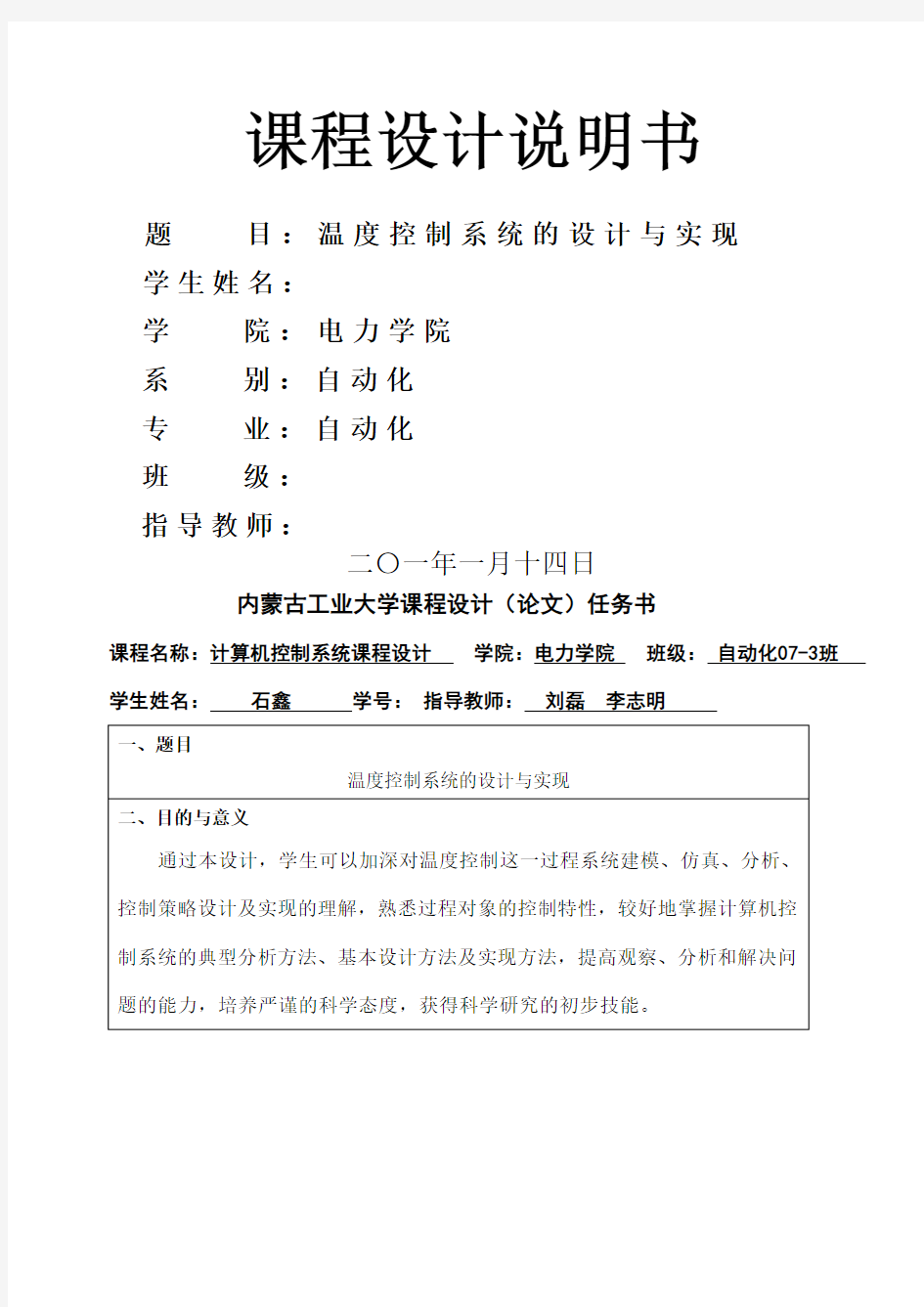计算机控制课程设计温度控制系统的设计与实现

- 1、下载文档前请自行甄别文档内容的完整性,平台不提供额外的编辑、内容补充、找答案等附加服务。
- 2、"仅部分预览"的文档,不可在线预览部分如存在完整性等问题,可反馈申请退款(可完整预览的文档不适用该条件!)。
- 3、如文档侵犯您的权益,请联系客服反馈,我们会尽快为您处理(人工客服工作时间:9:00-18:30)。
课程设计说明书
题目:温度控制系统的设计与实现
学生姓名:
学院:电力学院
系别:自动化
专业:自动化
班级:
指导教师:
二〇一年一月十四日
内蒙古工业大学课程设计(论文)任务书
课程名称:计算机控制系统课程设计学院:电力学院班级:自动化07-3班学生姓名:石鑫学号:指导教师:刘磊李志明
摘要
温度控制系统是一种典型的过程控制系统,在工业生产中具有极其广泛的应用。温度控制系统的对象存在滞后,它对阶跃信号的响应会推迟一些时间,对自动控制产生不利的影响,因此对温度准确的测量和有效的控制是此类工业控制系统中的重要指标。温度是一个重要的物理量,也是工业生产过程中的主要工艺参数之一,物体的许多性质和特性都与温度有关,很多重要的过程只有在一定温度范围内才能有效的进行,因此,对温度的精确测量和可靠控制,在工业生产和科学研究中就具有很重要的意义。
本文阐述了过程控制系统的概念,介绍了一种温度控制系统建模与控制,以电热水壶为被控对象,通过实验的方法建立温度控制系统的数学模型,采用了PID算法进行系统的设计,达到了比较好的控制目的。
关键词:温度控制;建模;自动控制;过程控制;PID
Abstract
In industrial production with extremely extensive application, temperature control system is a typical process control system.Temperature control system has the larger inertia. It is the response signal to step off some of time.And it produces the adverse effect to the temperature measurement. The control system is the important industrial control index. Temperature is an important parameters in the process of industrial production. Also it is one of the main parameters of objects, many properties and characteristics of temperature, many important process only under certain temperature range can efficiently work. Therefore, the precise measurement of temperature control, reliable industrial production and scientific research has very important significance.
This paper discusses the concept of process control system and introduces a kind of temperature control system .The electric kettle is the controlled object, PID algorithm is used for system design,through experience method to get the model of temperature control system and we can get the controlied response well. Keywords:Temperature control; Mathematical modeling; Automatic control; Process control; PID
目录
第一章概述 ............................................................
1.1 题目背景及应用意义..............................................
1.2 本文内容及工作安排 (1)
第二章系统组成及被控对象分析(被控对象数学建模) (3)
2.1 系统组成 (3)
2.1 被控对象分析(被控对象数学建模) (5)
第三章控制策略设计及仿真研究 (11)
3.1 控制策略设计 (11)
3.2 仿真研究 (15)
第四章控制策略实现 (18)
4.1 组态环境下控制策略编程实现 (18)
4.2 力控软件 (18)
4.3 运行结果分析 (20)
第五章总结 (22)
参考文献 (23)
第一章概述
1.1题目背景及应用意义
在近四十年的时间里,电子计算机的发展经历了从电子管、晶体管、中小规模集成电路到大规模集成电路这样四个阶段,尤其是随着半导体集成技术的飞跃发展,七十年代初诞生了一代新型的电子计算机——微型计算机,使得计算机应用日益广泛;目前,计算机应用已渗透到各行各业,达到了前所未有的普及程度。一个由计算机技术为标志,包括新材料、宇航、生物工程、海洋工程等多种学科在内的新技术革命正在兴起。
伴随着科学技术的发展,计算机技术有了更高的飞跃,我们现在完全可以运用计算机和温度传感器对某处进行温度检测,而且我们可以很容易地做到实时温度检测和控制。
温度是工业控制中主要的被控参数之一,特别是在冶金、化工、建材、食品、机械等工业中,具有举足重轻的作用,因此,温度控制系统是典型的控制系统。对于不同场所、不同工艺、所需温度高低范围不同、精度不同,则采用的测温元件、测温
